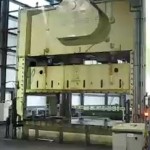OEE Formula
Your OEE calculation is based on a composite of the six big losses of your equipment broken down into three main areas; Availability, performance and quality. It is a very simple calculation in reality;
OEE = Availability% x Performance% x Quality%
OEE (Overall Equipment effectiveness) is the main performance measure that drives action within Total Productive Maintenance (TPM) and is used by the teams to focus their continuous improvement activities as well as identifying those areas that require resource.
TPM Six Losses
There are six equipment losses identified within TPM that are used to calculate your OEE;
- Availability
- Breakdowns
- Changeovers
- Performance
- Minor Stoppages
- Reduced Speed
- Quality
- Defects
- Setup Scrap
Each of these losses has to be monitored, measured and graphed to be able to calculate and understand your OEE.
Calculating Availability
Availability is the percentage of time available to run the machine within a shift after losses due to setups and breakdowns. It is calculated by recording the time lost due to breakdowns (unplanned stoppages of more than 10 minutes) in minutes and the time lost during setup (Last good part of one product to the first good part of the next) also in minutes, we then compare this to the total available time within the shift.
Example;
The shift is 8 hours long and we have 10 minutes allocated for maintenance work and cleaning each shift. Therefore we have 8 x 60 – 10 minutes or 470 minutes maximum available time.
If we lose an hour of production, 20 minutes due to breakdowns and 40 minutes for setups then our percentage availability is;
Total time available – Breakdowns – Changeover x100
Total Time Available
470 – 20 – 40 x 100 = 87%
470 .
Performance Calculation
The performance percentage is based around the total number of parts that are produced within your available time compared to how many you should have made if you produced at the planned (design) rate. So in our example above with 410 available minutes, if our production rate is designed to be 1 part per minute we should have produced 410 parts. However this is often reduced by reduced speed losses (running machines slower than design speed) and minor stoppages (such as small jams that have to be cleared). In our example our actual production is only 350 parts, so our performance percentage is;
Total Number of parts produced
Available time X production rate
350 = 85%
410 x 1 .
Quality Calculation
Your percentage calculation for quality within your OEE measure compares the total number of parts produced and the total number of good parts. Product losses can be due to either bad quality parts produced during normal production or parts produced during a setup for a new product. In our example we have produced 350 parts, but of these 15 were lost through setup and 15 were defective products. Our quality percentage therefore becomes;
Good Parts x 100
Total Number of Parts Produced
350 – 15 – 15 x100 = 91%
350 .
OEE Example
We now have a figure for our individual measures and we can move forward to our OEE calculation, the OEE formula being;
OEE = Availability% x Reliability% x Quality%
So for our example above our OEE calculation is;
87% x 85% x 91% = 67%
OEE Calculation Video
World Class OEE
How do you know if your OEE is good enough or even world class? Well whatever your OEE may be you should be striving to minimise the six big losses with the following targets;
- Breakdowns Zero
- Setups Minimise (less than 10mins)
- Minor Stoppages Zero
- Reduced Speed Zero
- Defects Zero
- Setup Defects Minimise
World class figures are generally accepted as:
- Availability 90% +
- Performance 95% +
- Quality 99.9% +
- With OEE exceeding 85%
This is a very rough guide and every industry and process is different, the important thing is to continuously improve your OEE to reduce your costs and better serve your customers, stopping when you achieve “world class” would allow your competitors to eventually exceed you. Mastering your OEE calculation will help you to stay several steps ahead of the competition in your TPM program.
OEE Calculation Spreadsheet Download
I have seen a handy OEE spreadsheet which you can download to give you a simple guideline for your OEE calculation, or you can download from here.
Further OEE Resources
Some additional examples of OEE calculations can be viewed here at OEE.com and this simple PDF is also available.
OEE Reference Books;
The OEE Primer: Understanding Overall Equipment Effectiveness, Reliability, and Maintainability In depth investigation of OEE
OEE for Operators: Overall Equipment Effectiveness (Shopfloor Series) Productivity Press so Ideal for those that have to apply OEE.
If you have any questions about the OEE calculation, TPM or any other lean tool please feel free to leave it in the comments section below.


Hella,
Do you have any idea for calculating oee for die manufacturing.
For example we are machining a part of die about 3 Day. anda every part is diffrent.
Specialy I am talking about stamping tool anda die